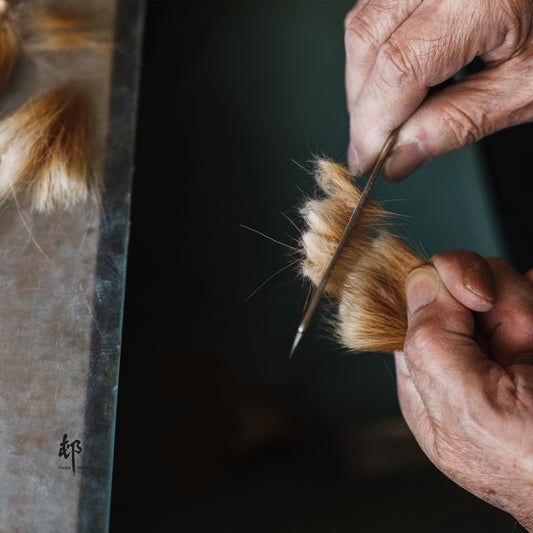Kategorie: 筆 Maki Fude (with core)
This is a type of brush where the core hairs are wrapped and solidified with washi paper. Then, additional fine hairs are applied, and the entire structure is further secured with hemp. It is also known as "Kamimaki Fude" or "Maki Fude." The characteristic features of this brush include excellent cohesion of the bristles and resilience.
Preserving the tradition of "Kamimaki Fude," a technique dating back 400 years to the founding of "Hankeido," is a testament to its enduring legacy. The only Maki Fude workshop. The brush comes in three types: "Jakuto-gata" (sparrow-shaped), "Ippan-gata" (general-purpose), and "Fujimaki-gata" (wrapped with wisteria vine), with a total of 20 varieties and 30 brushes being crafted.
Yūshinhitsu brushes are more suitable for calligraphy due to their distinctive structure.
3 types of Maki Fude
-

general type
To know moreA fude made by wrapping the core hair with washi paper and then adding the outer hair. At first glance, it may not look much different from a regular fude, but upon closer inspection, you can see that the tip suddenly becomes very thin from the part where the paper is wrapped.
-

sparrow head type
to know morePair text with an image to focus on your chosen product, collection, or blog post. Add details on availability, style, or even provide a review.
-

rattan-wrapped type
to know moreA large maki fude brush used for writing large Kanji characters, with the brush head and handle connected using rattan and wire mesh.
-
【創業400年 攀桂堂】Jakuto Fude (Sparrow-Head Brush)
Normaler Preis Von $30.00Normaler PreisStückpreis / pro -
【創業400年 攀桂堂】RYUTOMAKI FUDE in a paulownia box.
Normaler Preis Von $118.00Normaler PreisStückpreis / pro -
【創業400年 攀桂堂】Tenpyo Fude
Normaler Preis Von $98.00Normaler PreisStückpreis / pro -
【創業400年 攀桂堂】SHIBIEN
Normaler Preis $37.00Normaler PreisStückpreis / pro
what's new
Alle anzeigen-

Maki Fude (cored brushes) vs Suihitsu (non-core...
A Makifude has Japanese paper wrapped around its core; therefore, only about one-third of the bristles on a Makifude brush are exposed for use, while the bristles of a Suihitsu...
Maki Fude (cored brushes) vs Suihitsu (non-core...
A Makifude has Japanese paper wrapped around its core; therefore, only about one-third of the bristles on a Makifude brush are exposed for use, while the bristles of a Suihitsu...
-

Two different ways of making brushes
Fude making has been practiced throughout Japan for centuries, and while the manufacturing methods can vary somewhat depending on the region and shokunin, they can be broadly categorized into two...
Two different ways of making brushes
Fude making has been practiced throughout Japan for centuries, and while the manufacturing methods can vary somewhat depending on the region and shokunin, they can be broadly categorized into two...
-

Season of Sumi making is over this year. Sumi i...
The production of sumi ink takes place during winter. This is because one of the raw materials for sumi, Nikawa glue, may not solidify or may even rot when it...
Season of Sumi making is over this year. Sumi i...
The production of sumi ink takes place during winter. This is because one of the raw materials for sumi, Nikawa glue, may not solidify or may even rot when it...
-

Yoichi Hieda awarded at the 47th Yamaguchi Trad...
It is our great pleasure to announce that Yoichi Hieda is awarded the "Japan Crafts Association Yamaguchi Branch Director's Award", the equivalent of the first prize, at the 47th Yamaguchi...
Yoichi Hieda awarded at the 47th Yamaguchi Trad...
It is our great pleasure to announce that Yoichi Hieda is awarded the "Japan Crafts Association Yamaguchi Branch Director's Award", the equivalent of the first prize, at the 47th Yamaguchi...











